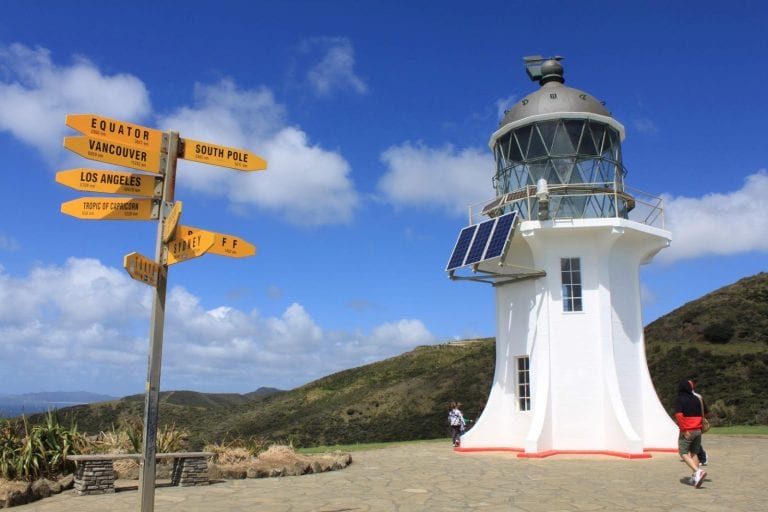Our final trip of the semester was up to Cape Reinga, the northernmost point of New Zealand. On Friday night we traveled about six hours north of Auckland by car, arriving at our charming Karikari Peninsula Airbnb to play games and get some rest before Saturday’s full schedule. The first stop on the day’s route was Ninety Mile Beach, an extensive strip of beach stretching the length of New Zealand’s northwest coast. We first explored the sandy shore by car, as it is one of the beaches in the country on which you can drive. After a brief cruise, we hopped out of the car to take on the beach by foot, taking in the view and getting as close to the water as we could, only to run away when the waves surged in.
Our next stop were the Te Paki sand dunes, where we braved the sharp winds to sandboard. Sharing three boards among the ten of us, we took turns braving the gusts to plunge down the steep dunes. Beginning on our stomach and graduating to standing up, sand boarding was much like snowboarding and came naturally to the more athletically inclined among us. The wind created a beautiful pattern in the sand but eventually wore on us, as our exposed faces, necks and ankles were pelted with grains of sand that felt like tiny shards of glass.
The day’s final destination was the northernmost point of New Zealand itself, the lighthouse at Cape Reinga. A long and winding path from the mainland out to the lighthouse is lined with greenery, evoking the feeling of an epic Disney-style journey. The trail’s end boast beautiful views of the meeting point of the Pacific Ocean and the Tasman Sea, with nothing but ocean as far as you can see in any given direction. Cape Reinga is the most spiritually significant place for the Maori people of New Zealand. It is thought that after death, spirits travel up the coast and out over the northernmost land point of the island. We sat in silence for a while, respectfully enjoying the feeling and the view.
That evening we watched the sunset on the beach near our house and made a big taco dinner. The following day we split up into two cars: those who needed to get back to Auckland to do schoolwork, and those who could take a bit more time. Where our paths differed were the hikes we took. I opted for the longer hike, having nothing due for school on Monday I figured I would extend this final trip as long as I could. My car went to hike Whangarei Heads, the longest and most grueling hike I did during my time in New Zealand. Beginning with two hours of straight and steep uphill climb, we then entered another three hours of up, down, up, down until descending for the final hour. By the time we reached hour three my legs were in pain, and I was unable to control where my foot landed when I stepped. The slippery mud that welcomed us from Friday’s rain was no help. All five of us struggled, but were determined to reach the views we knew awaited us. Once again, the route was worth it.
Our final descent brought us to Urquharts Bay, where we ripped off our boots and layed in the sun for an hour before taking the road back to the carpark in favor of doing the six hour hike again in the opposite direction. Nothing was special about the road route, other than the man who gave us water. Having been hiking for over seven hours, we had all run out of water and were desperate for more. We came across a house that displayed a sign offering fresh eggs for sale. We sent our most charismatic friend, Edo, into the yard where he met a sweet older couple who gladly filled our water bottles and asked us about our studies and hometowns. Being two Italians, a Norwegian and an American we gave then quite a variety of answers. That request for water remains the most characteristically New Zealand thing I’ve done -- asking a perfect stranger for a favor, and for them to automatically say yes without asking a single question -- and then becoming friends after a brief chat.





































































